| Revision as of 01:25, 8 March 2006 edit71.34.94.201 (talk)No edit summary← Previous edit | Latest revision as of 22:50, 6 January 2025 edit undoPH1997 (talk | contribs)29 editsNo edit summary | ||
| Line 1: | Line 1: | ||
| {{Short description|Köppen climate category}} | |||
| A '''continental climate''' is the climate typical of the middle-latitude interiors of the large continents of the ] in the zone of westerly winds; similar climates exist along the east coasts and southwest coasts of the same continents, and also at higher elevations in certain other parts of the world. This climate is characterized by ] ]s cold enough to support a fixed period of stable ] cover each year, and relatively low ] occurring mostly in summer - although east coast areas (chiefly in ]) may show an even distribution of precipitation. Only a few areas in ], adjacent ] and ] show a winter maximum in precipitation, which typically melts in early spring to give short-lived ]. | |||
| {{For|the influence of continental climates on viticulture|Climate categories in viticulture#Continental climates{{!}}continental climate (wine)}} | |||
| {{More citations needed|date=November 2007}} | |||
| ] | |||
| These regions generally have either forest or tall-grass prairie as natural groundcover and include some of the most productive farmlands in the world. All such climates have at least three months of temperatures in excess of 10°C and winters with at least one month below 0°C (although some classifications have a lower threshold for winter based on snow cover, in the ] -3°C is used). | |||
| '''Continental climates''' often have a significant annual variation in temperature (warm to hot summers and cold winters). They tend to occur in central and eastern parts of the three northern-tier continents (], ], and ]), typically in the middle latitudes (40 to 55 or 60 degrees north), often within large landmasses, where ] blow overland bringing some precipitation, and temperatures are not moderated by oceans. Continental climates occur mostly in the Northern Hemisphere due to the large landmasses found there. Most of northeastern ], eastern and southeastern ], much of ] south of the ], central and southeastern ], and the central and northeastern ] have this type of climate.<ref name=cc>{{cite encyclopedia|title=Continental Climate |url=http://www.ace.mmu.ac.uk/eae/climate/Older/Continental_Climate.html |archive-url=https://web.archive.org/web/20090427192955/http://www.ace.mmu.ac.uk/eae/climate/older/Continental_Climate.html |archive-date=2009-04-27 |encyclopedia=Encyclopedia of the Atmospheric Environment |publisher=] |url-status=dead }}</ref> '''Continentality''' is a measure of the degree to which a region experiences this type of climate.<ref name=cc /> | |||
| Most such areas fit ] of Dfa, Dwa (cold winters, long hot summers; "w" indicating very dry winters characteristic especially of China) or Dfb or Dwb (cold winters and long, mild summers, same distinction for winter dryness). | |||
| In continental climates, ] tends to be moderate in amount, concentrated mostly in the warmer months. Only a few areas—in the mountains of the ] of North America and in ], northern ], adjacent ], ], ], and ]—show a winter maximum in precipitation. A portion of the annual precipitation falls as snowfall, and snow often remains on the ground for more than a month. Summers in continental climates can feature thunderstorms and frequent hot temperatures; however, summer weather is somewhat more stable than winter weather. Continental climates are considered as ] varieties due to their location in the temperate zones,<ref>{{cite book |last1=Senker |first1=Cath |title=Temperate Climates |date=3 May 2018 |publisher=Raintree Publishers |isbn=9781474738408 |page=5 |url=https://books.google.com/books?id=jjRKDwAAQBAJ&q=continental+climates+temperate |access-date=23 June 2023}}</ref><ref>{{cite web |url=http://www.educationscotland.gov.uk/weatherandclimatechange/climate/worldclimates/temperate.asp |title=Weather & Climate Change: Climates around the world |publisher=] |archive-url=https://web.archive.org/web/20160414115206/http://www.educationscotland.gov.uk/weatherandclimatechange/climate/worldclimates/temperate.asp |archive-date=14 April 2016}}</ref> but are classified separately from other temperate climates in the ] system where they are identified by their first letter, a capital '''D'''. In the ], they are identified as '''Dc'''. | |||
| Continental climates exist where cold air masses infiltrate during the winter and warm air masses form in summer under conditions of high sun and long days. Places with continental climates are as a rule either far from any moderating effects of oceans (example: ], USA) or are so situated (example: ], USA) that prevailing winds tend to head offshore. Such regions get quite warm in the summer, achieving temperatures characteristic of tropical climates but are much colder than any other climates of similar latitude in the winter. | |||
| ==Köppen climate classification== | |||
| These climates grade off toward ]s equatorward where winters are less severe, ] climate poleward where summers are shorter and winters are more severe, ]s where precipitation becomes inadequate for tall-grass prairies. In Europe these climates may grade off into ]s in which the influence of moderating air masses is more marked toward the west. | |||
| Continental climate has at least one month averaging below {{convert|0|°C|°F|0}} and at least one month averaging above {{convert|10|°C|°F|0}}.<ref name=Peel>{{cite journal |author1=Peel, M. C. |author2=Finlayson B. L. |author3=McMahon, T. A. |name-list-style=amp |year=2007 |title=Updated world map of the Köppen–Geiger climate classification |journal=Hydrol. Earth Syst. Sci. |volume=11 |issue=5 |pages=1633–1644 |doi=10.5194/Hess-11-1633-2007 |issn=1027-5606|url=https://www.hydrol-earth-syst-sci.net/11/1633/2007/hess-11-1633-2007.pdf |bibcode=2007HESS...11.1633P |doi-access=free }}</ref><ref name="kottek2006">{{cite journal|last1=Kottek|first1=Markus|last2=Grieser|first2=Jürgen|last3=Beck|first3=Christoph|last4=Rudolf|first4=Bruno |last5=Rubel|first5=Franz|title=World Map of the Köppen-Geiger climate classification updated|journal=Meteorologische Zeitschrift|date=2006|volume=15|issue=3|pages=259–263|doi=10.1127/0941-2948/2006/0130|bibcode=2006MetZe..15..259K|url=https://opus.bibliothek.uni-augsburg.de/opus4/files/40083/metz_Vol_15_No_3_p259-263_World_Map_of_the_Koppen_Geiger_climate_classification_updated_55034.pdf}}</ref> | |||
| ] | |||
| * ''Dfa'' = Hot-summer ]; coldest month averaging below {{convert|0|°C|°F|0}} (or {{convert|-3|°C|°F|0}}), at least one month's average temperature above {{convert|22|°C|°F|1}}, and at least four months averaging above {{convert|10|°C|°F|0}}. No significant precipitation difference between seasons (neither the abovementioned set of conditions fulfilled). | |||
| * ''Dfb'' = Warm-summer ]; coldest month averaging below {{convert|0|°C|°F|0}} (or {{convert|-3|°C|°F|0}}), all months with average temperatures below {{convert|22|°C|°F|1}}, and at least four months averaging above {{convert|10|°C|°F|0}}. No significant precipitation difference between seasons (neither the abovementioned set of conditions fulfilled). | |||
| * ''Dfc'' = ]; coldest month averaging below {{convert|0|°C|°F|0}} (or {{convert|-3|°C|°F|0}}) and one–three months averaging above {{convert|10|°C|°F|0}}. No significant precipitation difference between seasons (neither the abovementioned set of conditions fulfilled). | |||
| * ''Dfd'' = Extremely cold subarctic climate; coldest month averaging below {{convert|−38|°C|°F|1}} and one–three months averaging above {{convert|10|°C|°F|0}}. No significant precipitation difference between seasons (neither the abovementioned set of conditions fulfilled). | |||
| ] | |||
| * ''Dwa'' = Monsoon-influenced hot-summer humid continental climate; coldest month averaging below {{convert|0|°C|°F|0}} (or {{convert|-3|°C|°F|0}}), at least one month's average temperature above {{convert|22|°C|°F|1}}, and at least four months averaging above {{convert|10|°C|°F|0}}. At least ten times as much rain in the wettest month of summer as in the driest month of winter. | |||
| * ''Dwb'' = Monsoon-influenced warm-summer humid continental climate; coldest month averaging below {{convert|0|°C|°F|0}} (or {{convert|-3|°C|°F|0}}), all months with average temperatures below {{convert|22|°C|°F|1}}, and at least four months averaging above {{convert|10|°C|°F|0}}. At least ten times as much rain in the wettest month of summer as in the driest month of winter. | |||
| * ''Dwc'' = Monsoon-influenced ]; coldest month averaging below {{convert|0|°C|°F|0}} (or {{convert|-3|°C|°F|0}}) and one–three months averaging above {{convert|10|°C|°F|0}}. At least ten times as much rain in the wettest month of summer as in the driest month of winter. | |||
| * ''Dwd'' = Monsoon-influenced extremely cold ]; coldest month averaging below {{convert|−38|°C|°F|1}} and one–three months averaging above {{convert|10|°C|°F|0}}. At least ten times as much rain in the wettest month of summer as in the driest month of winter. | |||
| ] | |||
| * ''Dsa'' = ]-influenced hot-summer humid continental climate; coldest month averaging below {{convert|0|°C|°F|0}} (or {{convert|-3|°C|°F|0}}), average temperature of the warmest month above {{convert|22|°C|°F|1}} and at least four months averaging above {{convert|10|°C|°F|0}}. At least three times as much precipitation in the wettest month of winter as in the driest month of summer, and the driest month of summer receives less than {{convert|30|mm|in|1|abbr=on}}. | |||
| * ''Dsb'' = Mediterranean-influenced warm-summer humid continental climate; coldest month averaging below {{convert|0|°C|°F|0}} (or {{convert|-3|°C|°F|0}}), average temperature of the warmest month below {{convert|22|°C|°F|1}} and at least four months averaging above {{convert|10|°C|°F|0}}. At least three times as much precipitation in the wettest month of winter as in the driest month of summer, and the driest month of summer receives less than {{convert|30|mm|in|1|abbr=on}}. | |||
| * ''Dsc'' = Mediterranean-influenced subarctic climate; coldest month averaging below {{convert|0|°C|°F|0}} (or {{convert|-3|°C|°F|0}}) and one–three months averaging above {{convert|10|°C|°F|0}}. At least three times as much precipitation in the wettest month of winter as in the driest month of summer, and the driest month of summer receives less than {{convert|30|mm|in|1|abbr=on}}. | |||
| * ''Dsd'' = Mediterranean-influenced extremely cold subarctic climate; coldest month averaging below {{convert|−38|°C|°F|1}} and one–three months averaging above {{convert|10|°C|°F|0}}. At least three times as much precipitation in the wettest month of winter as in the driest month of summer, and the driest month of summer receives less than {{convert|30|mm|in|1|abbr=on}}. | |||
| ==Seasons== | |||
| The ], parts of ], and most of ] are examples of areas of the world with continental climates, which do not exist at all in the Southern Hemisphere due to the lack of broad land masses at middle latitudes, the southernmost parts of Africa and Australia being under marine influences and southern South America being too narrow in breadth to allow air masses as cold as those in corresponding latitudes in North America and Asia to form in the winter. Antarctica, of course, lies completely outside the middle latitudes. | |||
| Annual precipitation in this zone is usually between {{convert|600|mm|in}} and {{convert|1200|mm|in}}, The timing of intermediate spring-like or autumn-like temperatures in this zone vary depending on latitude and/or elevation. For example, spring may arrive as soon as March (in ], September in ]) in the southern (in Northern hemisphere, northern in Southern hemisphere), parts of this zone or as late as May (November) in the north (south). Summers are warm or hot while winters are below freezing and sustain lots of frost. | |||
| ==Climatology== | |||
| Continental climates exist where cold air masses infiltrate during the winter from shorter days and warm air masses form in summer under conditions of high sun and longer days. Places with continental climates are as a rule either far from any moderating effect of oceans or are so situated that prevailing winds tend to head offshore.<ref>{{Cite web |date=2019-05-21 |title=What Is a Continental Climate? |url=https://www.worldatlas.com/articles/what-is-the-continental-climate.html |access-date=2022-04-04 |website=WorldAtlas |language=en-US}}</ref> Such regions get quite warm in the summer, achieving temperatures characteristic of tropical climates but are colder than any other climates of similar latitude in the winter. | |||
| ==Neighboring climates== | |||
| In the Köppen climate system, these climates grade off toward ]s equator-ward where winters are less severe and ]s or ]s where precipitation becomes inadequate for tall-grass ]s and shrublands. In Europe these climates may grade off into ]s ('''Cfb''') or ]s ('''Cfc''') in which the influence of cool oceanic air masses is more marked toward the west. In western and eastern Asia, and the central United States these climates grade off toward ]s ('''Cfa/Cwa'''), ]s ('''Cwb'''), or ]s ('''Csa/Csb''') to the south. | |||
| ==List of locations with a continental climate== | |||
| <sup>{{note|1|1}}The climate is continental if the 0 °C coldest-month isotherm is used, but it is temperate if the -3 °C isotherm is used.</sup> | |||
| ===]=== | |||
| ====]==== | |||
| *]{{ref|1|1}} (bordering ''Cfb'') | |||
| ===]=== | |||
| ====]==== | |||
| ], Japan]] | |||
| *]: ] (''Dsb''), ]{{ref|1|1}} (''Dsa'' bordering ''Csa''), ] (''Dsa'' bordering ''BSk''), ] (''Dsb''), ] (''Dsa'') | |||
| *]: ], ] (''Dsb'' bordering ''Dfb''), ], ], ], ] (bordering ''BSk'') | |||
| *]: ]{{ref|1|1}} (bordering ''Cfa''), ]{{ref|1|1}} (bordering ''Cfa'') | |||
| *]: ], ]{{ref|1|1}}, ], ], ], ], ], ], ], ], ], ], ], ], ]{{ref|1|1}} (bordering ''Cwa''), ]{{ref|1|1}} (bordering ''Cwa''), ], ], ], ], ]{{ref|1|1}}, ], ], ], ], ], ], ] (bordering ''BSk''), ]{{ref|1|1}} (bordering ''Cwa''), ], ]{{ref|1|1}}, ] | |||
| *]: ]{{ref|1|1}} | |||
| *]: ]{{ref|1|1}} (bordering ''Cfb''), ] (''Dsb'' bordering ''Dfb'') | |||
| *]: ] (''Dsb''), ]{{ref|1|1}} (''Dsa'' bordering ''BSk''), ]{{ref|1|1}} (bordering ''BSk''), ]{{ref|1|1}} (''Dsa'' bordering ''BSk''), ]{{ref|1|1}} (''Dsa''), ]{{ref|1|1}} (''Dsa''), ]{{ref|1|1}} (''Dsa'' bordering ''BSk''), ]{{ref|1|1}} (bordering ''BSk'') | |||
| *]: ]{{ref|1|1}}, ], ]{{ref|1|1}}, ], ]{{ref|1|1}}, ]{{ref|1|1}}, ]{{ref|1|1}}, ]{{ref|1|1}} (bordering ''Cfa''), ]{{ref|1|1}} (bordering ''Cfa''), ], ], ]{{ref|1|1}} , ]{{ref|1|1}} (bordering ''Cfa''), ]{{ref|1|1}} (bordering ''Cfa''), ]{{ref|1|1}} | |||
| *]: ], ], ]{{ref|1|1}} (''Dsa'' bordering ''BSk''), ], ], ], ], ], ]{{ref|1|1}} (''Dsa''), ] (''Dsa'' bordering ''BSk'') | |||
| *]: ]{{ref|1|1}} (''Dsa''), ]{{ref|1|1}} (''Dsa''), ], ]{{ref|1|1}} (''Dsa'') | |||
| *]: ] (bordering ''Dwc''), ], ], ] | |||
| *]: ], ]{{ref|1|1}}, ], ], ], ], ], ], ], ], ], ]{{ref|1|1}} | |||
| *]: ] (bordering ''BSk''), ], ], ], ], ] (bordering ''Dwc''), ], ], ], ], ], ], ] (bordering ''Dfc''), ], ], ], ], ], ], ], ], ], ] | |||
| *]: ]{{ref|1|1}}, ]{{ref|1|1}}, ]{{ref|1|1}}, ], ]{{ref|1|1}}, ]{{ref|1|1}}, ], ]{{ref|1|1}}, ], ]{{ref|1|1}}, ]{{ref|1|1}}, ]{{ref|1|1}}, ], ]{{ref|1|1}} (bordering ''Cfa''), ] | |||
| *]: ]{{ref|1|1}} (disputed with Georgia) | |||
| *]: ]{{ref|1|1}} (''Dsa''), ]{{ref|1|1}} (''Dsa''), ]{{ref|1|1}} (''Dsa''), ] (''Dsb'') | |||
| *]: ] (''Dsb''), ], ] (''Dsa''), ]{{ref|1|1}} (bordering ''BSk/Cfa''), ]{{ref|1|1}} (bordering ''Cfa/Cfb''), ], ] (''Dsa''), ], ]{{ref|1|1}} (''Dsa''), ] (''Dsa''), ] (''Dsb''), ]{{ref|1|1}} (''Dsa'') | |||
| *]: ]{{ref|1|1}} (''Dsa'' bordering ''Csa'') | |||
| ====]==== | |||
| ] valley, France]] | |||
| ] | |||
| ] | |||
| *]: ]{{ref|1|1}} | |||
| *]: ]{{ref|1|1}}, ]{{ref|1|1}} (bordering ''Dfc'') | |||
| *]: ]{{ref|1|1}} (bordering ''Cfb'') , ]{{ref|1|1}}, ]{{ref|1|1}}, ]{{ref|1|1}}, ]{{ref|1|1}} , ], ]{{ref|1|1}} | |||
| *]: ], ]{{ref|1|1}}, ], ], ], ], ] | |||
| *]: ]{{ref|1|1}}, ]{{ref|1|1}}, ]{{ref|1|1}} | |||
| *]: ]{{ref|1|1}} (bordering ''Cfa''), ]{{ref|1|1}}, ]{{ref|1|1}}, ]{{ref|1|1}} (bordering ''Cfa''), ]{{ref|1|1}} (''Dsb''), ]{{ref|1|1}} (bordering ''Cfb''), ]{{ref|1|1}}, ]{{ref|1|1}} | |||
| *]: ]{{ref|1|1}} | |||
| *]: ]{{ref|1|1}}, ]{{ref|1|1}}, ]{{ref|1|1}}, ]{{ref|1|1}} , ]{{ref|1|1}}, ]{{ref|1|1}} (bordering ''Cfb''), ]{{ref|1|1}} | |||
| *]: ]{{ref|1|1}}, ], ]{{ref|1|1}}, ], ] | |||
| *]: ]{{ref|1|1}}, ], ], ], ] (bordering ''Dfc''), ] (bordering ''Dfc''), ], ], ] (bordering ''Dfc''), ] | |||
| *]: ]{{ref|1|1}}, ]{{ref|1|1}}, ]{{ref|1|1}} (bordering ''Dfc'') | |||
| *]: ]{{ref|1|1}}, ]{{ref|1|1}} (bordering ''Cfb''), ]{{ref|1|1}}, ]{{ref|1|1}}, ]{{ref|1|1}} (bordering ''Cfb''), ]{{ref|1|1}} , ]{{ref|1|1}}, ]{{ref|1|1}}, ]{{ref|1|1}}, ]{{ref|1|1}} | |||
| *]: ]{{ref|1|1}}, ]{{ref|1|1}}, ]{{ref|1|1}} | |||
| *]: ]{{ref|1|1}}, ]{{ref|1|1}} (bordering ''Cfa/Cfb''), ]{{ref|1|1}}, ]{{ref|1|1}}, ]{{ref|1|1}} (bordering ''Cfa/Cfb''), ]{{ref|1|1}} (bordering ''Cfb''), ]{{ref|1|1}} (bordering ''Cfa'') | |||
| *]: ]{{ref|1|1}} (bordering ''Cfb''), ], ], ]{{ref|1|1}} , ]{{ref|1|1}} (bordering ''Cfb''), ] | |||
| *]: ] (bordering ''BSk'') | |||
| *]: ]{{ref|1|1}} (disputed with Serbia) | |||
| *]: ], ]{{ref|1|1}}, ]{{ref|1|1}}, ]{{ref|1|1}} | |||
| *]: ]{{ref|1|1}} (bordering ''Cfb'') | |||
| *]: ], ]{{ref|1|1}}, ]{{ref|1|1}}, ] | |||
| *]: ], ], ]{{ref|1|1}}, ]{{ref|1|1}} | |||
| *]: ]{{ref|1|1}}, ]{{ref|1|1}} | |||
| *]: ]{{ref|1|1}} , ]{{ref|1|1}} | |||
| *]: ]{{ref|1|1}} (bordering ''Dfc''), ], ], ] (bordering ''Dfc''), ]{{ref|1|1}}, ]{{ref|1|1}}, ]{{ref|1|1}}, ]{{ref|1|1}} | |||
| *]: ]{{ref|1|1}}, ]{{ref|1|1}}, ]{{ref|1|1}}, ]{{ref|1|1}} (bordering ''Cfb''), ]{{ref|1|1}}, ]{{ref|1|1}}, ]{{ref|1|1}}, ]{{ref|1|1}}, ]{{ref|1|1}}, ]{{ref|1|1}}, ]{{ref|1|1}}, ]{{ref|1|1}} (bordering ''Cfb''), ]{{ref|1|1}}, ], ]{{ref|1|1}}, ]{{ref|1|1}}, ]{{ref|1|1}} (bordering ''Cfb'') | |||
| *]: ], ]{{ref|1|1}}, ]{{ref|1|1}}, ]{{ref|1|1}}, ]{{ref|1|1}}, ]{{ref|1|1}}, ], ]{{ref|1|1}}, ]{{ref|1|1}}, ]{{ref|1|1}} | |||
| *]: ], ], ], ]{{ref|1|1}}, ], ]{{ref|1|1}}, ], ], ], ], ], ], ], ], ], ], ] (bordering ''Dfc''), ], ], ], ], ], ], ]{{ref|1|1}}, ]{{ref|1|1}}, ], ], ], ], ]{{ref|1|1}}, ], ] (bordering ''BSk''), ], ], ]{{ref|1|1}} | |||
| *]: ]{{ref|1|1}}, ]{{ref|1|1}}, ]{{ref|1|1}} | |||
| *]: ], ]{{ref|1|1}}, ]{{ref|1|1}} , ]{{ref|1|1}}, ]{{ref|1|1}}, ]{{ref|1|1}}, ]{{ref|1|1}} | |||
| *]: ]{{ref|1|1}} (bordering ''Cfb''), ]{{ref|1|1}} | |||
| *]: ]{{ref|1|1}} (''Dsb'' bordering ''Csb'') | |||
| *]: ], ], ], ]{{ref|1|1}}, ]{{ref|1|1}} (bordering ''Cfb''), ]{{ref|1|1}}, ]{{ref|1|1}}, ]{{ref|1|1}}, ]{{ref|1|1}}, ]{{ref|1|1}}, ], ]{{ref|1|1}}, ]{{ref|1|1}}, ]{{ref|1|1}} (bordering ''Cfb'') | |||
| *]: ], ] (bordering ''Dfc''), ]{{ref|1|1}}, ]{{ref|1|1}} | |||
| *]: ]{{ref|1|1}} (disputed with Moldova) | |||
| *]: ], ], ] (]), ]{{ref|1|1}} (bordering ''Cfa''), ], ]{{ref|1|1}}, ], ], ], ] (occupied by Russia), ]{{ref|1|1}}, ]{{ref|1|1}} (occupied by Russia), ]{{ref|1|1}}, ]{{ref|1|1}} (bordering ''BSk/Cfa''), ], ]{{ref|1|1}}, ], ], ] | |||
| ===]=== | |||
| ====]==== | |||
| {{div col|colwidth=20em}} | |||
| *] | |||
| *], MB | |||
| *] (higher areas are ''Dwc'') | |||
| *], BC{{ref|1|1}} (''Dsb'' bordering ''Dfb'') | |||
| *] | |||
| *] | |||
| *] | |||
| *] | |||
| *], AB (bordering ''Dfc'') | |||
| *] (bordering ''Dfc'') | |||
| *] | |||
| *] | |||
| *], BC{{ref|1|1}} | |||
| *] | |||
| *] | |||
| *], ON | |||
| *], QC | |||
| *], NL{{ref|1|1}} | |||
| *] | |||
| *] | |||
| *] | |||
| *] | |||
| *], QC | |||
| *] | |||
| *], BC{{ref|1|1}} (bordering ''BSk'') | |||
| *] | |||
| *] | |||
| *] | |||
| *] | |||
| *] (bordering ''BSk'') | |||
| *], QC | |||
| *]{{ref|1|1}} (bordering ''Cfb'') | |||
| *] | |||
| *], QC | |||
| *], QC | |||
| *] | |||
| *] (bordering ''BSk'') | |||
| *]{{ref|1|1}} | |||
| *] | |||
| *] | |||
| *] | |||
| *], ON | |||
| *] | |||
| *], QC | |||
| *] | |||
| *] | |||
| *]{{ref|1|1}} | |||
| {{div col end}} | |||
| <gallery class="center"> | |||
| File:Edmonton River Valley.jpg|alt=Edmonton River Valley|North Saskatchewan River valley in Edmonton | |||
| File:Forks Riverwalk.jpg|], with ] in the background in Winnipeg | |||
| File:Skyline as viewed from Sam Smith.jpg|Toronto skyline taken from Colonel Samuel Smith Park in ] | |||
| File:Downtown view from SAIT.JPG|Downtown Calgary from ] (SAIT) campus | |||
| File:Le Stade Olympique 3.jpg|Olympic Stadium in Montreal | |||
| File:Québec City shore.JPG|Quebec City shore | |||
| </gallery> | |||
| ====]==== | |||
| =====]===== | |||
| ]]] | |||
| ] | |||
| *] | |||
| *]{{ref|1|1}} | |||
| *] | |||
| *]{{ref|1|1}} | |||
| *] | |||
| *] | |||
| *]{{ref|1|1}} | |||
| *]{{ref|1|1}} (bordering ''Cfa'') | |||
| *]{{ref|1|1}} | |||
| *] | |||
| *] | |||
| *]{{ref|1|1}} (bordering ''Cfa'') | |||
| *]{{ref|1|1}} (] is ''Cfa'') | |||
| *]{{ref|1|1}} | |||
| *]{{ref|1|1}} | |||
| *]{{ref|1|1}} | |||
| *] | |||
| *]{{ref|1|1}} | |||
| *]{{ref|1|1}} | |||
| *] | |||
| *] | |||
| *] | |||
| *] | |||
| *] | |||
| *] | |||
| *] | |||
| *] | |||
| *] | |||
| *]{{ref|1|1}} | |||
| *] | |||
| *]{{ref|1|1}} (bordering ''Cfa'') | |||
| *] | |||
| *]{{ref|1|1}} | |||
| *] | |||
| *] | |||
| *]{{ref|1|1}} (bordering ''Cfa'') | |||
| *] | |||
| *] | |||
| *] | |||
| *] | |||
| *] | |||
| *] | |||
| *] | |||
| *] (bordering ''BSk'') | |||
| *] | |||
| *] | |||
| *] | |||
| *] | |||
| *] | |||
| *]{{ref|1|1}} | |||
| *]{{ref|1|1}} | |||
| *] | |||
| *]{{ref|1|1}} | |||
| *]{{ref|1|1}} | |||
| *]{{ref|1|1}} | |||
| *]{{ref|1|1}} | |||
| =====]===== | |||
| ] | |||
| ] | |||
| ] from ]]] | |||
| *] | |||
| *]{{ref|1|1}} | |||
| *]{{ref|1|1}} | |||
| *] | |||
| *] | |||
| *] | |||
| *]{{ref|1|1}} | |||
| *]{{ref|1|1}} (bordering ''Cfa'') | |||
| *] | |||
| *] | |||
| *]{{ref|1|1}} (Outer Cape and ] are ''Cfb'') | |||
| *] | |||
| *]{{ref|1|1}} | |||
| *]{{ref|1|1}} (] and riverfront (including ]) are ''Cfa'') | |||
| *]{{ref|1|1}} | |||
| *] | |||
| *] | |||
| *]{{ref|1|1}} (bordering ''Cfa'') | |||
| *]{{ref|1|1}} (bordering ''Cfa'') | |||
| *]{{ref|1|1}} | |||
| *] | |||
| *] | |||
| *] | |||
| *]{{ref|1|1}} | |||
| *]{{ref|1|1}} | |||
| *] | |||
| *]{{ref|1|1}} | |||
| *]{{ref|1|1}} | |||
| *]{{ref|1|1}} (bordering ''Cfa'') | |||
| *]{{ref|1|1}} (bordering ''Cfa/Cfb'') | |||
| *]{{ref|1|1}} (bordering ''Cfa'') | |||
| *]{{ref|1|1}} | |||
| *]{{ref|1|1}} (bordering ''Cfa'') | |||
| *]{{ref|1|1}} (bordering ''Cfa'') | |||
| *] | |||
| *] | |||
| *]{{ref|1|1}} | |||
| *]{{ref|1|1}} (bordering ''Cfa'') | |||
| *]{{ref|1|1}} | |||
| *]{{ref|1|1}} | |||
| *]{{ref|1|1}} (north side facing ] is ''Cfa'') | |||
| *] | |||
| *]{{ref|1|1}} | |||
| *]{{ref|1|1}} (bordering ''Cfa'') | |||
| *]{{ref|1|1}} | |||
| *] | |||
| *]{{ref|1|1}} | |||
| *] | |||
| *] | |||
| *]{{ref|1|1}} (bordering ''Cfa'') | |||
| *]{{ref|1|1}} | |||
| *]{{ref|1|1}} | |||
| *] | |||
| *]{{ref|1|1}} (bordering ''Cfa'') | |||
| =====]===== | |||
| ] in ], NC/TN]] | |||
| *]{{ref|1|1}} | |||
| *]{{ref|1|1}} (bordering ''Cfb'') | |||
| *]{{ref|1|1}} (bordering ''Cfa'') | |||
| *]{{ref|1|1}} (bordering ''Cfa'') | |||
| *]{{ref|1|1}} (bordering ''Cfa'') | |||
| *]{{ref|1|1}} | |||
| *], DE{{ref|1|1}} (bordering ''Cfa'') | |||
| *]{{ref|1|1}} | |||
| *]{{ref|1|1}} (bordering ''Cfa'') | |||
| *]{{ref|1|1}} (bordering ''Cfa'') | |||
| *]{{ref|1|1}} | |||
| *], NC/TN | |||
| *], NC | |||
| *]{{ref|1|1}} | |||
| *]{{ref|1|1}} | |||
| *]{{ref|1|1}} (bordering ''Cfa'') | |||
| *]{{ref|1|1}} | |||
| *]{{ref|1|1}} | |||
| *]{{ref|1|1}} (bordering ''Cfa'') | |||
| =====]===== | |||
| ] | |||
| ] | |||
| ] | |||
| ]]] | |||
| *]{{ref|1|1}} (''Dsb'' bordering ''BSk/Csb'') | |||
| *] | |||
| *]{{ref|1|1}} (bordering ''BSk'') | |||
| *] | |||
| *] (''Dsa'') | |||
| *]{{ref|1|1}} (bordering ''BSk'') | |||
| *]{{ref|1|1}} (''Dsb'' bordering ''Csb'') | |||
| *] (bordering ''Dfc'') | |||
| *]{{ref|1|1}} (bordering ''BSk'') | |||
| *]{{ref|1|1}} (''Dsb'' bordering ''Csb/Csc/Dsc'') | |||
| *] (bordering ''BSk'') | |||
| *] (bordering ''Dfc'') | |||
| *] | |||
| *]{{ref|1|1}} (bordering ''Dfc'') | |||
| *] | |||
| *]{{ref|1|1}} (''Dsb'') | |||
| *]{{ref|1|1}} (bordering ''Cfb/Cfc/Dfc'') | |||
| *]{{ref|1|1}} (''Dsb'' bordering ''Csb'') | |||
| *] (''Dsa'') | |||
| *]{{ref|1|1}} (bordering ''BSk'') | |||
| *]{{ref|1|1}} (bordering ''BSk'') | |||
| *]{{ref|1|1}} (''Dsb'') | |||
| *] | |||
| *]{{ref|1|1}} (''Dsb'') | |||
| *] (bordering ''BSk'') | |||
| *] (bordering ''Dfc'') | |||
| *]{{ref|1|1}} (''Dsa'') | |||
| *]{{ref|1|1}} (''Dsb'' bordering ''Dsa'') | |||
| *] | |||
| *]{{ref|1|1}} | |||
| *] | |||
| *]{{ref|1|1}} (''Dsa'' bordering ''BSk/Csa'') | |||
| *]{{ref|1|1}} (bordering ''BSk'') | |||
| *] (''Dsb'' bordering ''Dsc'') | |||
| *]{{ref|1|1}} (''Dsb'' bordering ''Csb'') | |||
| *]{{ref|1|1}} (''Dsb'' bordering ''Csa/Csb/Dsa'') | |||
| *] | |||
| *]{{ref|1|1}} (''Dsb'') | |||
| *] (bordering ''BSk'') | |||
| *] | |||
| *]{{ref|1|1}} (bordering ''BSk'') | |||
| *] (''Dsb'') | |||
| ===]=== | |||
| ====]==== | |||
| ] | |||
| *]{{ref|1|1}}, Victoria (bordering ''Dfc'') | |||
| *]{{ref|1|1}}, New South Wales (bordering ''Cfb'') | |||
| *]{{ref|1|1}}, Victoria (bordering ''Cfb/Cfc/Dfc'') | |||
| *]{{ref|1|1}}, New South Wales (bordering ''Cfb/Cfc/Dfc'') | |||
| ===]=== | |||
| ====]==== | |||
| ] | |||
| *]{{ref|1|1}}, ] (''Dsb'' bordering ''BSk/Csb/Csc/Dsc'') | |||
| *]{{ref|1|1}}, ] (''Dsb'') | |||
| *]{{ref|1|1}}, ] (''Dsb'' bordering ''Csb'') | |||
| ==See also== | ==See also== | ||
| *] | * ] | ||
| *] | * ] | ||
| *] | * ] | ||
| *] | * ] | ||
| *] | |||
| ==References== | |||
| *]. | |||
| {{Reflist}} | |||
| ==External links== | |||
| {{Commons category}} | |||
| {{Koppen}} | |||
| ] | |||
| {{Authority control}} | |||
| ] | |||
| ] | |||
| ] | |||
| ] | |||
| ] | |||
| ] | |||
| ] | |||
| ] | |||
| ] | |||
| ] | |||
| ] | |||
| ] | |||
Latest revision as of 22:50, 6 January 2025
Köppen climate category For the influence of continental climates on viticulture, see continental climate (wine).| This article needs additional citations for verification. Please help improve this article by adding citations to reliable sources. Unsourced material may be challenged and removed. Find sources: "Continental climate" – news · newspapers · books · scholar · JSTOR (November 2007) (Learn how and when to remove this message) |

Continental climates often have a significant annual variation in temperature (warm to hot summers and cold winters). They tend to occur in central and eastern parts of the three northern-tier continents (North America, Europe, and Asia), typically in the middle latitudes (40 to 55 or 60 degrees north), often within large landmasses, where prevailing winds blow overland bringing some precipitation, and temperatures are not moderated by oceans. Continental climates occur mostly in the Northern Hemisphere due to the large landmasses found there. Most of northeastern China, eastern and southeastern Europe, much of Russia south of the Arctic Circle, central and southeastern Canada, and the central and northeastern United States have this type of climate. Continentality is a measure of the degree to which a region experiences this type of climate.
In continental climates, precipitation tends to be moderate in amount, concentrated mostly in the warmer months. Only a few areas—in the mountains of the Pacific Northwest of North America and in Iran, northern Iraq, adjacent Turkey, Afghanistan, Pakistan, and Central Asia—show a winter maximum in precipitation. A portion of the annual precipitation falls as snowfall, and snow often remains on the ground for more than a month. Summers in continental climates can feature thunderstorms and frequent hot temperatures; however, summer weather is somewhat more stable than winter weather. Continental climates are considered as temperate climate varieties due to their location in the temperate zones, but are classified separately from other temperate climates in the Köppen climate classification system where they are identified by their first letter, a capital D. In the Trewartha climate classification, they are identified as Dc.
Köppen climate classification
Continental climate has at least one month averaging below 0 °C (32 °F) and at least one month averaging above 10 °C (50 °F).
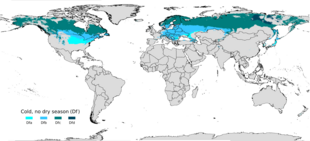
- Dfa = Hot-summer humid continental climate; coldest month averaging below 0 °C (32 °F) (or −3 °C (27 °F)), at least one month's average temperature above 22 °C (71.6 °F), and at least four months averaging above 10 °C (50 °F). No significant precipitation difference between seasons (neither the abovementioned set of conditions fulfilled).
- Dfb = Warm-summer humid continental climate; coldest month averaging below 0 °C (32 °F) (or −3 °C (27 °F)), all months with average temperatures below 22 °C (71.6 °F), and at least four months averaging above 10 °C (50 °F). No significant precipitation difference between seasons (neither the abovementioned set of conditions fulfilled).
- Dfc = Subarctic climate; coldest month averaging below 0 °C (32 °F) (or −3 °C (27 °F)) and one–three months averaging above 10 °C (50 °F). No significant precipitation difference between seasons (neither the abovementioned set of conditions fulfilled).
- Dfd = Extremely cold subarctic climate; coldest month averaging below −38 °C (−36.4 °F) and one–three months averaging above 10 °C (50 °F). No significant precipitation difference between seasons (neither the abovementioned set of conditions fulfilled).

- Dwa = Monsoon-influenced hot-summer humid continental climate; coldest month averaging below 0 °C (32 °F) (or −3 °C (27 °F)), at least one month's average temperature above 22 °C (71.6 °F), and at least four months averaging above 10 °C (50 °F). At least ten times as much rain in the wettest month of summer as in the driest month of winter.
- Dwb = Monsoon-influenced warm-summer humid continental climate; coldest month averaging below 0 °C (32 °F) (or −3 °C (27 °F)), all months with average temperatures below 22 °C (71.6 °F), and at least four months averaging above 10 °C (50 °F). At least ten times as much rain in the wettest month of summer as in the driest month of winter.
- Dwc = Monsoon-influenced subarctic climate; coldest month averaging below 0 °C (32 °F) (or −3 °C (27 °F)) and one–three months averaging above 10 °C (50 °F). At least ten times as much rain in the wettest month of summer as in the driest month of winter.
- Dwd = Monsoon-influenced extremely cold subarctic climate; coldest month averaging below −38 °C (−36.4 °F) and one–three months averaging above 10 °C (50 °F). At least ten times as much rain in the wettest month of summer as in the driest month of winter.
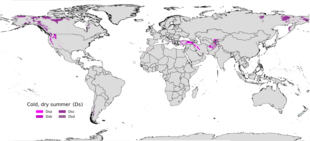
- Dsa = Mediterranean-influenced hot-summer humid continental climate; coldest month averaging below 0 °C (32 °F) (or −3 °C (27 °F)), average temperature of the warmest month above 22 °C (71.6 °F) and at least four months averaging above 10 °C (50 °F). At least three times as much precipitation in the wettest month of winter as in the driest month of summer, and the driest month of summer receives less than 30 mm (1.2 in).
- Dsb = Mediterranean-influenced warm-summer humid continental climate; coldest month averaging below 0 °C (32 °F) (or −3 °C (27 °F)), average temperature of the warmest month below 22 °C (71.6 °F) and at least four months averaging above 10 °C (50 °F). At least three times as much precipitation in the wettest month of winter as in the driest month of summer, and the driest month of summer receives less than 30 mm (1.2 in).
- Dsc = Mediterranean-influenced subarctic climate; coldest month averaging below 0 °C (32 °F) (or −3 °C (27 °F)) and one–three months averaging above 10 °C (50 °F). At least three times as much precipitation in the wettest month of winter as in the driest month of summer, and the driest month of summer receives less than 30 mm (1.2 in).
- Dsd = Mediterranean-influenced extremely cold subarctic climate; coldest month averaging below −38 °C (−36.4 °F) and one–three months averaging above 10 °C (50 °F). At least three times as much precipitation in the wettest month of winter as in the driest month of summer, and the driest month of summer receives less than 30 mm (1.2 in).
Seasons
Annual precipitation in this zone is usually between 600 millimetres (24 in) and 1,200 millimetres (47 in), The timing of intermediate spring-like or autumn-like temperatures in this zone vary depending on latitude and/or elevation. For example, spring may arrive as soon as March (in Northern hemisphere, September in Southern hemisphere) in the southern (in Northern hemisphere, northern in Southern hemisphere), parts of this zone or as late as May (November) in the north (south). Summers are warm or hot while winters are below freezing and sustain lots of frost.
Climatology
Continental climates exist where cold air masses infiltrate during the winter from shorter days and warm air masses form in summer under conditions of high sun and longer days. Places with continental climates are as a rule either far from any moderating effect of oceans or are so situated that prevailing winds tend to head offshore. Such regions get quite warm in the summer, achieving temperatures characteristic of tropical climates but are colder than any other climates of similar latitude in the winter.
Neighboring climates
In the Köppen climate system, these climates grade off toward temperate climates equator-ward where winters are less severe and semi-arid climates or arid climates where precipitation becomes inadequate for tall-grass prairies and shrublands. In Europe these climates may grade off into oceanic climates (Cfb) or subpolar oceanic climates (Cfc) in which the influence of cool oceanic air masses is more marked toward the west. In western and eastern Asia, and the central United States these climates grade off toward humid subtropical climates (Cfa/Cwa), subtropical highland climates (Cwb), or Mediterranean climates (Csa/Csb) to the south.
List of locations with a continental climate
Africa
Morocco
- Imilchil (bordering Cfb)
Eurasia
Asia

- Afghanistan: Chaghcharan (Dsb), Fayzabad (Dsa bordering Csa), Ghazni (Dsa bordering BSk), Maidan Shar (Dsb), Puli Alam (Dsa)
- Armenia: Gyumri, Jermuk (Dsb bordering Dfb), Kapan, Sisian, Vanadzor, Yerevan (bordering BSk)
- Azerbaijan: Qabala (bordering Cfa), Shamakhi (bordering Cfa)
- China: Anshan, Beijing, Biru County, Changchun, Chengde, Dalian, Daqing, Hailin, Harbin, Huludao, Hulunbuir, Heihe, Jiamusi, Jilin, Jinan (bordering Cwa), Linyi (bordering Cwa), Mudanjiang, Qinhuangdao, Qiqihar, Shenyang, Shigatse, Siping, Songyuan, Suihua, Tangshan, Tieling, Ulanhot, Ürümqi (bordering BSk), Xi'an (bordering Cwa), Yanji, Yantai, Yichun
- Georgia: Akhaltsikhe
- India: Badrinath (bordering Cfb), Dras (Dsb bordering Dfb)
- Iran: Abali (Dsb), Arak (Dsa bordering BSk), Ardabil (bordering BSk), Hamadan (Dsa bordering BSk), Saqqez (Dsa), Sardasht (Dsa), Tabriz (Dsa bordering BSk), Urmia (bordering BSk)
- Japan: Aomori, Asahikawa, Hakodate, Kushiro, Morioka, Mount Aso, Mutsu, Nagano (bordering Cfa), Nichinan (bordering Cfa), Obihiro, Sapporo, Tendō , Tome (bordering Cfa), Yamagata (bordering Cfa), Yokote
- Kazakhstan: Aktobe, Almaty, Arys (Dsa bordering BSk), Astana, Karaganda, Oskemen, Pavlodar, Semey, Shymkent (Dsa), Taraz (Dsa bordering BSk)
- Kyrgyzstan: Bishkek (Dsa), Jalal-Abad (Dsa), Karakol, Osh (Dsa)
- Mongolia: Baruunturuun (bordering Dwc), Darkhan, Kharkhorin, Sükhbaatar
- North Korea: Chongjin, Haeju, Hamhung, Hoeryong, Kaesong, Kimchaek, Nampo, Pyongyang, Rason, Sinuiju, Tanchon, Wonsan
- Russia: Abakan (bordering BSk), Barnaul, Birobidzhan, Blagoveshchensk, Chelyabinsk, Chita (bordering Dwc), Gorno-Altaysk, Irkutsk, Kemerovo, Khabarovsk, Krasnoyarsk, Komsomolsk-on-Amur, Kurilsk (bordering Dfc), Kurgan, Nakhodka, Novosibirsk, Omsk, Tomsk, Tyumen, Vladivostok, Yekaterinburg, Yuzhno-Kurilsk, Yuzhno-Sakhalinsk
- South Korea: Bucheon, Cheonan, Cheongju, Chuncheon, Chupungnyeong, Daejeon, Goyang, Incheon, Pyeongchang, Seongnam, Seoul, Suwon, Wonju, Yeongcheon (bordering Cfa), Yongin
- South Ossetia: Tskhinvali (disputed with Georgia)
- Tajikistan: Isfara (Dsa), Konibodom (Dsa), Panjakent (Dsa), Roghun (Dsb)
- Turkey: Ağrı (Dsb), Ardahan, Bitlis (Dsa), Çankırı (bordering BSk/Cfa), Çorum (bordering Cfa/Cfb), Erzurum, Hakkâri (Dsa), Kars, Kayseri (Dsa), Muş (Dsa), Sivas (Dsb), Van (Dsa)
- Uzbekistan: Chirchiq (Dsa bordering Csa)
Europe
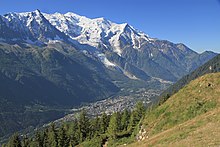


- Albania: Pogradec
- Andorra: Canillo, El Pas de la Casa (bordering Dfc)
- Austria: Baden bei Wien (bordering Cfb) , Innsbruck, Klagenfurt, Klösterle, Neukirchen bei Lambach , Villach, Wiener Neustadt
- Belarus: Barysaw, Brest, Gomel, Grodno, Minsk, Pinsk, Vitebsk
- Bosnia and Herzegovina: Goražde, Istočno Sarajevo, Livno
- Bulgaria: Pazardzhik (bordering Cfa), Pernik, Pleven, Ruse (bordering Cfa), Smolyan (Dsb), Sofia (bordering Cfb), Veliko Tarnovo, Vratsa
- Croatia: Gospić
- Czech Republic: Brno, České Budějovice, Liberec, Olomouc , Ostrava, Pardubice (bordering Cfb), Plzeň
- Estonia: Hiiumaa, Pärnu, Saaremaa, Tallinn, Tartu
- Finland: Åland, Hämeenlinna, Helsinki, Kouvola, Kuopio (bordering Dfc), Lahti (bordering Dfc), Lappeenranta, Pori, Tampere (bordering Dfc), Turku
- France: Chamonix, Mouthe, Saint-Véran (bordering Dfc)
- Germany: Ansbach, Augsburg (bordering Cfb), Bayreuth, Garmisch-Partenkirchen, Görlitz (bordering Cfb), Ingolstadt , Kempten, Regensburg, Sigmaringen, Weiden in der Oberpfalz
- Greece: Aetomilitsa, Kato Vermio, Samarina
- Hungary: Debrecen, Kecskemét (bordering Cfa/Cfb), Miskolc, Nyíregyháza, Szeged (bordering Cfa/Cfb), Szombathely (bordering Cfb), Szolnok (bordering Cfa)
- Italy: Belluno (bordering Cfb), Bruneck, Cortina d'Ampezzo, Rhêmes-Notre-Dame , Rocca di Mezzo (bordering Cfb), Toblach
- Kazakhstan: Oral (bordering BSk)
- Kosovo: Pristina (disputed with Serbia)
- Latvia: Daugavpils, Jelgava, Liepāja, Riga
- Liechtenstein: Schaan (bordering Cfb)
- Lithuania: Kaunas, Klaipėda, Šiauliai, Vilnius
- Moldova: Bălți, Briceni, Chișinău, Comrat
- Montenegro: Pljevlja, Žabljak
- North Macedonia: Berovo , Bitola
- Norway: Bodø (bordering Dfc), Drammen, Hamar, Lillehammer (bordering Dfc), Oslo, Sarpsborg, Steinkjer, Trondheim
- Poland: Białystok, Bydgoszcz, Gdańsk, Gorzów Wielkopolski (bordering Cfb), Katowice, Kielce, Kraków, Łódź, Lublin, Olsztyn, Opole, Poznań (bordering Cfb), Rzeszów, Suwałki, Toruń, Warsaw, Zielona Góra (bordering Cfb)
- Romania: Brașov, Bucharest, Cluj-Napoca, Craiova, Galați, Iași, Miercurea Ciuc, Oradea, Ploiești, Sibiu
- Russia: Belgorod, Bryansk, Cheboksary, Grozny, Izhevsk, Kaliningrad, Kazan, Kirov, Kursk, Moscow, Nalchik, Nizhny Novgorod, Orenburg, Pskov, Perm, Penza, Petrozavodsk (bordering Dfc), Rostov-on-Don, Ryazan, Saint Petersburg, Samara, Saratov, Smolensk, Stavropol, Taganrog, Tula, Tver, Ufa, Ulyanovsk, Vladikavkaz, Vladimir, Volgograd (bordering BSk), Voronezh, Yaroslavl, Yeysk
- Serbia: Nova Varoš, Subotica, Zaječar
- Slovakia: Banská Bystrica, Košice, Pezinok , Nitra, Prešov, Trnava, Žilina
- Slovenia: Lendava (bordering Cfb), Murska Sobota
- Spain: Puerto de Navacerrada (Dsb bordering Csb)
- Sweden: Falun, Gävle, Härnösand, Jönköping, Kalmar (bordering Cfb), Karlstad, Linköping, Norrköping, Örebro, Stockholm, Sundsvall, Uppsala, Västerås, Visby (bordering Cfb)
- Switzerland: Gstaad, La Brévine (bordering Dfc), La Chaux-de-Fonds, Poschiavo
- Transnistria: Tiraspol (disputed with Moldova)
- Ukraine: Chernihiv, Dnipro, Donetsk (occupied by Russia), Izmail (bordering Cfa), Kharkiv, Kherson, Khmelnytskyi, Kryvyi Rih, Kyiv, Luhansk (occupied by Russia), Lviv, Mariupol (occupied by Russia), Mykolaiv, Odesa (bordering BSk/Cfa), Poltava, Uzhhorod, Vinnytsia, Zaporizhzhia, Zhytomyr
North America
Canada
- Brampton
- Brandon, MB
- Calgary (higher areas are Dwc)
- Castlegar, BC (Dsb bordering Dfb)
- Charlottetown
- Edmonton
- Fredericton
- Gander, NL
- Grande Prairie, AB (bordering Dfc)
- Goose Bay, NL (bordering Dfc)
- Halifax
- Hamilton, ON
- Kelowna, BC
- Kitchener, ON
- Laval, QC
- London, ON
- Longueuil, QC
- Marystown, NL
- Mississauga
- Moncton
- Montreal
- Moose Factory
- Murdochville, QC
- Ottawa
- Penticton, BC (bordering BSk)
- Prince Albert, SK
- Prince George, BC
- Quebec City
- Red Deer, AL
- Regina (bordering BSk)
- Rimouski, QC
- Sable Island (bordering Cfb)
- Saint John, NB
- Saguenay, QC
- Sherbrooke, QC
- St. John's, NL
- Saskatoon (bordering BSk)
- Stewart, BC
- Sudbury
- Sydney, NS
- Thunder Bay
- Timmins, ON
- Toronto
- Trois-Rivières, QC
- Windsor
- Winnipeg
- Yarmouth, NS
-
 North Saskatchewan River valley in Edmonton
North Saskatchewan River valley in Edmonton
-
 The Forks, with St. Boniface Cathedral in the background in Winnipeg
The Forks, with St. Boniface Cathedral in the background in Winnipeg
-
 Toronto skyline taken from Colonel Samuel Smith Park in Etobicoke
Toronto skyline taken from Colonel Samuel Smith Park in Etobicoke
-
Downtown Calgary from Southern Alberta Institute of Technology (SAIT) campus
-
 Olympic Stadium in Montreal
Olympic Stadium in Montreal
-
Quebec City shore
United States
Midwest


- Aberdeen, SD
- Akron, OH
- Ann Arbor, MI
- Athens, OH
- Aurora, IL
- Bismarck, ND
- Bloomington, IN
- Cahokia Heights, IL (bordering Cfa)
- Canton, OH
- Champaign, IL
- Chicago
- Chillicothe, OH (bordering Cfa)
- Cincinnati (downtown is Cfa)
- Cleveland
- Columbia, MO
- Columbus, OH
- Davenport, IA
- Dayton
- Decatur, IL
- Des Moines
- Detroit
- Duluth, MN
- Eau Claire, WI
- Fargo, ND
- Flint, MI
- Fort Wayne, IN
- Grand Rapids, MI
- Green Bay, WI
- Indianapolis
- Kalamazoo, MI
- Kansas City (bordering Cfa)
- Lansing, MI
- Lawrence, KS
- Lincoln, NE
- Madison, WI
- Marietta, OH (bordering Cfa)
- Marquette, MI
- Milwaukee
- Minneapolis
- North Platte, NE
- Omaha
- Oshkosh, WI
- Peoria
- Rapid City, SD (bordering BSk)
- Rochester, MN
- Rockford, IL
- Saginaw, MI
- Sioux Falls, SD
- South Bend, IN
- Springfield, IL
- St. Charles, MO
- St. Cloud, MN
- St. Joseph, MO
- Toledo, OH
- Topeka
- Youngstown, OH
Northeast
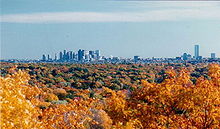


- Albany
- Allentown, PA
- Altoona, PA
- Augusta, ME
- Bangor, ME
- Binghamton, NY
- Boston
- Bridgeport, CT (bordering Cfa)
- Buffalo
- Burlington, VT
- Cape Cod (Outer Cape and Chatham are Cfb)
- Concord, NH
- Erie, PA
- Harrisburg (downtown and riverfront (including City Island) are Cfa)
- Hartford
- Ithaca, NY
- Johnstown, PA
- Lancaster, PA (bordering Cfa)
- Lansdale, PA (bordering Cfa)
- Lawrence, MA
- Lewiston, ME
- Lowell, MA
- Manchester, NH
- Matinicus Isle, ME
- Morristown, NJ
- Nashua, NH
- New Bedford, MA
- New Haven
- New London, CT (bordering Cfa)
- Newport, RI (bordering Cfa/Cfb)
- Paterson, NJ (bordering Cfa)
- Pittsburgh
- Plainfield, NJ (bordering Cfa)
- Plymouth, MA (bordering Cfa)
- Portland, ME
- Portsmouth, NH
- Poughkeepsie, NY
- Princeton, NJ (bordering Cfa)
- Providence, RI
- Reading, PA
- Riverhead, NY (north side facing Long Island Sound is Cfa)
- Rochester
- Scranton, PA
- Somerville, NJ (bordering Cfa)
- Southampton, NY
- Springfield, MA
- State College, PA
- Syracuse
- Utica, NY
- West Chester, PA (bordering Cfa)
- White Plains, NY
- Williamsport, PA
- Worcester, MA
- York, PA (bordering Cfa)
South

- Beech Mountain, NC
- Boone, NC (bordering Cfb)
- Buckhannon, WV (bordering Cfa)
- Cincinnati/Northern Kentucky International Airport (bordering Cfa)
- Clifton Forge, VA (bordering Cfa)
- Cumberland, MD
- Ebright Azimuth, DE (bordering Cfa)
- Elkins, WV
- Emmitsburg, MD (bordering Cfa)
- Fairmont, WV (bordering Cfa)
- Hancock, MD
- Kuwohi, NC/TN
- Mount Mitchell, NC
- Oakland, MD
- Parkton, MD
- Romney, WV (bordering Cfa)
- Wheeling, WV
- White Sulphur Springs, WV
- Winchester, VA (bordering Cfa)
West
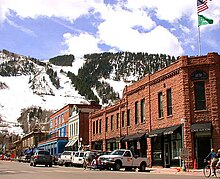
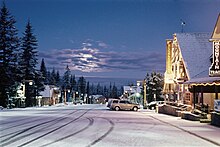
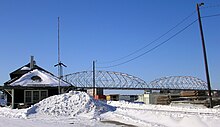

- Alturas, CA (Dsb bordering BSk/Csb)
- Aspen, CO
- Billings, MT (bordering BSk)
- Bozeman, MT
- Cambridge, ID (Dsa)
- Cheyenne, WY (bordering BSk)
- Coeur D'Alene, ID (Dsb bordering Csb)
- Fairbanks (bordering Dfc)
- Flagstaff, AZ (bordering BSk)
- Government Camp, OR (Dsb bordering Csb/Csc/Dsc)
- Idaho Falls (bordering BSk)
- Jackson, WY (bordering Dfc)
- Joseph, OR
- Juneau (bordering Dfc)
- Kalispell, MT
- Klamath Falls, OR (Dsb)
- Kodiak, AK (bordering Cfb/Cfc/Dfc)
- La Grande, OR (Dsb bordering Csb)
- Logan, UT (Dsa)
- Los Alamos, NM (bordering BSk)
- Loveland, CO (bordering BSk)
- Mammoth Lakes, CA (Dsb)
- Missoula, MT
- Moscow, ID (Dsb)
- Mountain City, NV (bordering BSk)
- Nenana, AK (bordering Dfc)
- Ogden, UT (Dsa)
- Orofino, ID (Dsb bordering Dsa)
- Park City, UT
- Petersburg, AK
- Pocatello, ID
- Salt Lake City (Dsa bordering BSk/Csa)
- Santa Fe, NM (bordering BSk)
- Skagway, AK (Dsb bordering Dsc)
- South Lake Tahoe, CA (Dsb bordering Csb)
- Spokane, WA (Dsb bordering Csa/Csb/Dsa)
- Steamboat Springs, CO
- Tahoe City, CA (Dsb)
- Taos, NM (bordering BSk)
- Telluride, CO
- Tusayan, AZ (bordering BSk)
- Winthrop, WA (Dsb)
Oceania
Australia
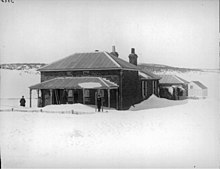
- Falls Creek, Victoria (bordering Dfc)
- Kiandra, New South Wales (bordering Cfb)
- Mount Buller, Victoria (bordering Cfb/Cfc/Dfc)
- Perisher Valley, New South Wales (bordering Cfb/Cfc/Dfc)
South America
Argentina
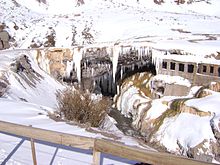
- Alto Río Senguer, Chubut Province (Dsb bordering BSk/Csb/Csc/Dsc)
- Las Leñas, Mendoza Province (Dsb)
- Puente del Inca, Mendoza Province (Dsb bordering Csb)
See also
References
- ^ "Continental Climate". Encyclopedia of the Atmospheric Environment. Manchester Metropolitan University. Archived from the original on 2009-04-27.
- Senker, Cath (3 May 2018). Temperate Climates. Raintree Publishers. p. 5. ISBN 9781474738408. Retrieved 23 June 2023.
- "Weather & Climate Change: Climates around the world". Education Scotland. Archived from the original on 14 April 2016.
- Peel, M. C.; Finlayson B. L. & McMahon, T. A. (2007). "Updated world map of the Köppen–Geiger climate classification" (PDF). Hydrol. Earth Syst. Sci. 11 (5): 1633–1644. Bibcode:2007HESS...11.1633P. doi:10.5194/Hess-11-1633-2007. ISSN 1027-5606.
- Kottek, Markus; Grieser, Jürgen; Beck, Christoph; Rudolf, Bruno; Rubel, Franz (2006). "World Map of the Köppen-Geiger climate classification updated" (PDF). Meteorologische Zeitschrift. 15 (3): 259–263. Bibcode:2006MetZe..15..259K. doi:10.1127/0941-2948/2006/0130.
- "What Is a Continental Climate?". WorldAtlas. 2019-05-21. Retrieved 2022-04-04.
External links
| Climate types under the Köppen climate classification | |
|---|---|
| Class A | |
| Class B | |
| Class C | |
| Class D | |
| Class E | |